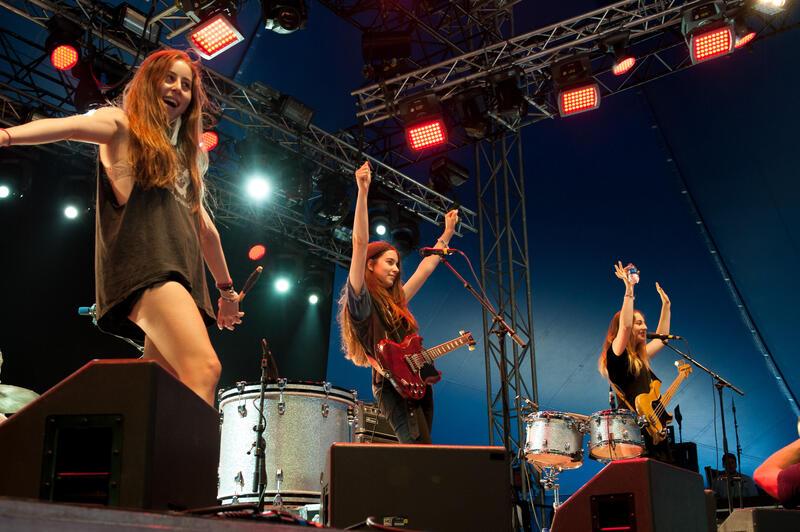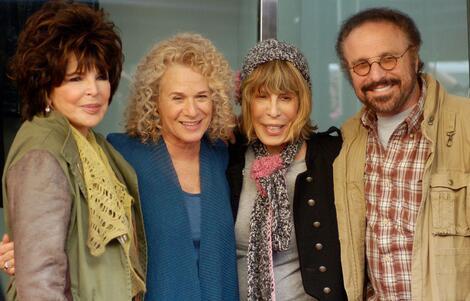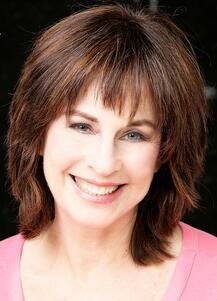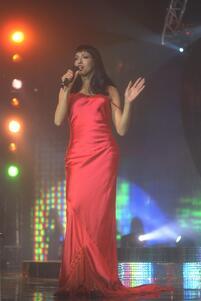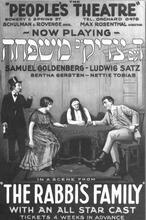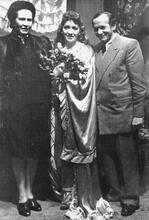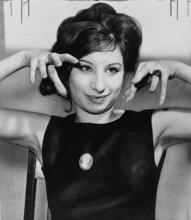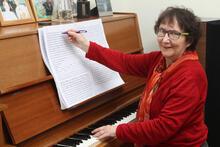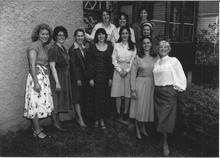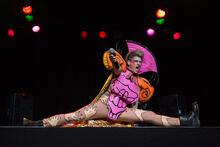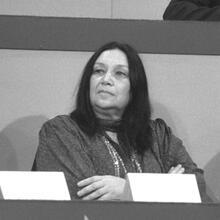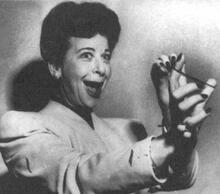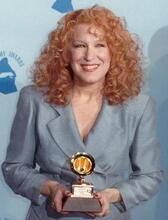Jewish Women in Contemporary Popular Music: 1950 to Present
Jewish women musicians have moved with the times, performing with bands, as solo acts, and as songwriters. In the 1950s, Jewish women contributed to the mainstream American pop repertoire largely produced by labels associated with the Brill Building in New York City. In the 1970s, 1980s, and 1990s, Jewish women performed in rock and roll, punk, and Riot Grrrl groups. Although Jewishness was less important than femaleness to many of these musicians, two great divas of the modern era, Bette Midler and Barbra Streisand, have been unapologetically Jewish. In Israel, a number of women have come to prominence through the Eurovision Song Contest.
By the 1950s, commercial radio had created a mass music market in the United States. Studio-created, vocal-driven pop music came into its own as a genre, along with rock and roll, folk, and punk. Jewish women musicians moved with the times, performing with bands, as solo acts, and as songwriters. They sang about popular topics rather than Jewish themes and made names for themselves as women musicians. For many years, the Jewishness of these popular musicians barely registered in their stage personas. However, a few performers have made their Jewish identities part of their musical work. Similarly, some Israeli artists have reached international audiences, often via performing at the Eurovision Song Contest.
The Brill Building
Located at 1619 Broadway in New York City, the Brill Building housed a significant portion of the American popular music industry from the 1930s through the 1960s. The songwriters, lyricists, and producers who worked at the Brill Building and at 1650 and 1697 Broadway produced a steady stream of popular music, performed by selected soloists and small groups. This type of 1960s pop music came to be known as the “Brill Building Sound.” Many of the professionals who worked at the Brill Building were Jewish, and a few were women.
The best known of the women songwriters at the Brill Building was Carole King (Carol Joan Klein, b. 1942). During the 1960s, King and her first husband, Gerry Goffin, wrote a large repertoire of hit songs. These included “Will You Love Me Tomorrow” (1961), performed by The Shirelles; “The Loco-Motion” (1962), performed by Little Eva; and “(You Make Me Feel Like) A Natural Woman” (1967), performed by Aretha Franklin. King began to perform her own music in 1968 and released her first solo album, Tapestry, in 1970. She continued to write and perform, eventually branching out into theater and film. In 2013, she became the first woman to receive the Gershwin Prize for Popular Song. In 2014, Beautiful: The Carole King Musical, a biographical musical based on her life, premiered on Broadway.
Cynthia Weil (b. 1940) also partnered with her husband Barry Mann to contribute to the Brill Building Sound. Weil’s lyrics gave their songs a particular weight; their repertoire combined a focus on political and social issues with a pop sound . She is credited on hits including “Blame it on the Bossa Nova” (1963), performed by Eydie Gormé; the Vietnam-era anthem “We Gotta Get out of This Place” (1965), performed by The Animals; and “You’ve Lost That Lovin’ Feelin’” (1964), co-written with Phil Spector and performed by The Righteous Brothers.
Among the performers who sang the music of Brill Building composers were Lesley Gore (Lesley Sue Goldstein, 1946 – 2015) and Eydie Gormé (Edith Gormezano, 1928 – 2013). Gore is best known as the performer of “It’s My Party” (1963) and its sequel “Judy’s Turn To Cry,” (1963) written by Beverly Ross (b. 1939), another Jewish songwriter associated with the Brill Building, and Edna Lewis, as well as the feminist anthem “You Don’t Own Me” (1963). Born to a Descendants of the Jews who lived in Spain and Portugal before the explusion of 1492; primarily Jews of N. Africa, Italy, the Middle East and the Balkans.Sephardic family in the Bronx, Gormé performed Latin pop in Spanish and in English. Her biggest solo success after “Blame it on the Bossa Nova” was “Sabor a mi” (“Taste of me,” 1964). Gormé also performed with her husband, Steve Lawrence (Sidney Leibowitz), as “Steve and Eydie” between 1957 and 2010.
From Rock and Punk to Riot Grrrl and Pop
In the 1960s, a generation of Jewish women musicians who were the children of World War II veterans or Holocaust survivors, or who were even child Holocaust survivors themselves, began to come of age. They became part of the rock and punk scenes, performing for audiences consisting of other children of Holocaust survivors. However, many of these performers, and the generation that followed them, were known more as women artists than as Jewish artists.
The first all-female rock band to be signed to a major label was Goldie and the Gingerbreads, led by Goldie Zelkowitz (Genyusha Zelkowicz, b. 1940). Born in Łódź, Poland, Zelkowitz had survived both the Holocaust and the DP camps as a small child before immigrating to New York. As a teenager, she rebelled by seeking out danger and countercultural expression. Zelkowitz formed Goldie and the Gingerbreads in 1962. The band was signed to Decca in 1963, and then to Atlantic in 1964. Goldie and the Gingerbreads lasted until 1967.
Zelkowitz went on to form the band Ten Wheel Drive in 1968, changing her stage name to Genya Ravan and working increasingly as a solo artist after 1974. Around the same time, she began to work as a record producer, becoming the first woman to produce major male bands. She worked for several major labels, including Sire Records, Polydor, and her own label, Polish Records.
Helen Wheels (Helen Robbins, 1949 – 2000) made a name for herself in punk during the same era when Ravan was working in rock. Wheels was the Reform Jewish daughter of a housewife who later became a feminist. In 1967, as a student at CUNY, she met Albert Bouchard and began to design costumes for his band Soft White Underbelly, which became Blue Öyster Cult in 1971. Wheels also contributed lyrics to five of the group’s records, earning two gold albums and one platinum album. Her own punk band, called the Helen Wheels Band, performed largely on the East Coast of the United States between 1977 and 1987. She won the ASCAP award for Best New Writer and Publisher in 1978, and in 1986 the Helen Wheels Band was nominated for “Best Heavy Metal Band” in the inaugural New York City Music Awards. Wheels took up bodybuilding in 1981 and established a small-press imprint, Fort Tryon Press Ltd., in 1995.
Although Ravan and Wheels were not overwhelmingly successful as performers, they opened space for other Jewish women to perform in rock and punk. The space they created was largely one of outsiderness. Many Jewish rock and punk artists either did not highlight or actively downplayed their Jewishness, and indeed a strong thread of antisemitism characterized the punk scene of the 1980s and 1990s. A powerful culture of sexism existed, too, and women musicians responded to this sexism through the Riot Grrrl movement.
Riot Grrrl began in the Pacific Northwest in the 1990s. The movement blended female anger and the fight against male-dominated power structures with a playful approach to the signs and signals of femininity and a do-it-yourself aesthetic inherited from punk. Although Jewish women, including Carrie Brownstein (b. 1974) and Janet Weiss (b. 1965) of the band Sleater-Kinney, and women of at least partial Jewish descent, including Courtney Love (b. 1964), participated in Riot Grrrl bands, the movement was primarily concerned with feminism rather than Jewishness.
More recently, the New York-based rock band The Shondes, founded in 2006, has blended Riot Grrrl-influenced feminist punk with Jewish political and cultural statements and LGBT perspectives. Its lead singer and bassist, Louisa Rachel Solomon (b. 1982), former drummer Temim Fruchter (b. 1979), and other largely Jewish and LGBT musicians combined punk and klezmer elements and played for organizations that upheld their political advocacy for peace through justice between Palestine and Israel. The Shondes’ radical political activism has caused controversy with Jewish audiences. However, many Jewish radical arts organizations and news outlets have praised the group’s musical achievements in bringing an audible sense of Jewish cultural identity to Riot Grrrl-style pop music.
In the United Kingdom, the most notable Jewish female performer was singer-songwriter Amy Winehouse (1983 – 2011). Winehouse’s music blended soul with rhythm and blues, and she was known for her contralto voice and beehive hairstyle. Although much of her work was in live performance, she produced two albums. Her 2003 debut album, Frank, was nominated for a Mercury Prize, and her 2006 album Back to Black won five Grammy Awards in 2008. Winehouse also won three Ivor Novello awards, of which she was particularly proud, and the 2007 Brit Award for Best British Female Artist. Like her American counterparts, Winehouse’s Jewish identity played almost no role in her musical performance; although she sometimes performed wearing a large Magen David medallion, she was not religiously observant, occasionally attending her family’s Passover seder and going to the synagogue once a year, at Yom Kippur. Nevertheless, two years after her death, the Jewish Museum in London staged an exhibition about Winehouse that has bolstered her posthumous identity as a Jewish popular musician.
The Jewish Divas
Actress, singer, film director/producer, and founder of the Streisand Foundation, Barbra Streisand in 1962.
Photo from Wikimedia Commons.
Although many Jewish women who performed in various popular music scenes either did not call attention to their Jewishness or actively downplayed it, two of the most famous Jewish women performers of the twentieth century actively acknowledged and embraced their Jewish identity. Bette Midler (b. 1945) and Barbra Streisand (b. 1942) are as famous for being openly Jewish as they are for being diva-like performers. Their careers have encompassed both singing and acting. They both have large LGBT fan bases, and each has recalled other Jewish women performers from earlier generations.
Bette Midler famously made a name for herself singing and performing stand-up comedy at the Continental Baths, a gay bathhouse in New York City, in 1970. Her early repertoire emphasized popular standards from the 1940s, including “Boogie Woogie Bugle Boy,” “In The Mood,” and “Lullaby of Broadway,” covering the arrangements made famous by the Andrews Sisters. Midler alternated her songs with risqué jokes, prompting comparisons to Sophie Tucker. Eventually, she developed the stage character of “The Divine Miss M,” which was also the title of her debut album, released in 1972. Midler released three more albums during the 1970s: Bette Midler in 1973, Songs for the New Depression in 1976, and Broken Blossoms in 1977.
In 1979, Midler starred in the film The Rose as a drug-addicted popular singer reminiscent of Janis Joplin. From then on, she pursued a dual career as a comic actress and a successful singer and performer. In 1988, the two halves of her career came together when she starred in the film Beaches and also achieved her best-selling album with the soundtrack to the film. The featured song “Wind Beneath My Wings” achieved Platinum status in the United States. Midler followed it with a cover of Jewish composer Julie Gold’s “From a Distance” in 1990 that also achieved Platinum status.
In her stage act, Midler used a trio of backup singers called the Harlettes. Among the first of the rotating cast of Harlettes was a Jewish singer named Melissa Manchester (b. 1951). Like Midler, Manchester also followed a dual career track in singing and acting. Among Manchester’s achievements are “Through the Eyes of Love,” the theme song to the 1978 film Ice Castles; her Grammy-nominated 1979 recording of “Don’t Cry Out Loud”; and her 1983 Grammy-winning “You Should Hear How She Talks About You.”
Barbra Streisand (Barbara Joan Streisand) began her musical career in 1960 singing in Greenwich Village coffeehouses and made the transition to Broadway in 1962. Since then, she has also had a dual career as a singer and an actress. She is among the few performers to have won the Emmy, Grammy, Oscar, and Tony awards. Her voice is exceptionally flexible, with a wide range, and many of her albums have achieved Platinum status. Due to a fear of performing live, much of Streisand’s career has been in recording, including her signature song “The Way We Were” (1974), the theme song from her 1973 movie of the same name.
Like Midler, Streisand recalled another Jewish entertainer early in her career. In 1964, she starred on Broadway in the musical Funny Girl, playing Fanny Brice, and reprised the role in the 1968 film adaptation. Streisand has never concealed her Jewish identity. She kept her surname, and she famously refused get a nose job in the 1960s, as many Jewish girls and women were advised to do. In fact, she actively celebrated Jewishness in one of her best-known films, Yentl (1983). Streisand not only stars as the title character, a girl who disguises herself as a boy to study Torah, but she also produced, directed, and wrote the film, becoming the first woman ever to combine all of these role in a single film production. She attended Hebrew classes with her son, Jason, to prepare him for his Lit. "son of the commandment." A boy who has reached legal-religious maturity and is now obligated to fulfill the commandmentsbar mitzvah.
Streisand is both an outspoken feminist and LGBT rights activist. In 1979, she earned a significant LGBT following with her duet recording of “No More Tears (Enough is Enough)” with Donna Summer. She raised money in 2007 in an unsuccessful attempt to defeat a California ballot proposition and eventual state constitutional amendment banning same-sex marriage. She has also donated money and performance time to other progressive political causes. In 2013, she performed a rare concert tour in Israel, including a performance in Jerusalem to celebrate the 90th birthday of Shimon Peres, at that time the President of Israel.
Israel
Israel has participated in the Eurovision Song Contest since 1973. The contest has brought international attention to several female pop musicians. The first contestant for Israel was Ilanit (Hanna Dresner-Tzakh, b. 1947), formerly of the duo “Ilan & Ilanit.” Ilanit placed fourth in the competition with the song “Ey Sham” (“Somewhere”), composed by Nurit Hirsch.
Hirsch (b. 1942) also composed and conducted the orchestra for “A-Ba-Ni-Bi,” the song that won Israel’s first Eurovision title in 1978. Hirsch studied piano, composition, orchestration, and conducting and completed her IDF military service in the entertainment corps. She has entered and won numerous Israeli and international song contests. Her best-known compositions are “Bashana Haba’a” (“Next Year”), from 1971, and her setting of the prayer “Oseh Shalom,” which won the first Hasidic Song Festival in 1969 and has been adopted into the liturgy of synagogues around the world.
In 1983, Ofra Haza (1957 – 2000), a singer of Yemenite descent, took second place at Eurovision with the song “Chai” (“Life”). This song, built around a metaphor of national resilience, became a hit in Europe. In 1984, her album Shirei Teiman (“Yemenite songs”) won her international recognition. Many of her subsequent albums received both critical and popular acclaim. Her music fused Eastern and Western styles, blending Israeli and Yemenite folk melodies with Middle Eastern percussion, Western classical instrumentation, and contemporary synthpop dance beats. During the 1990s, Haza collaborated with other international recording artists, including Thomas Dolby, Paula Abdul, Sarah Brightman, and Iggy Pop. Haza also performed on movie soundtracks, most notably as the voice of Yocheved in the 1998 DreamWorks animated film The Prince of Egypt. She died in 2000, of AIDS-related pneumonia. Then-Prime Minister Ehud Barak praised her as an Israeli cultural emissary for her musical career.
Haza’s 1983 Eurovision performance inspired another performer of Yemenite Jewish descent, Dana International (Sharon Cohen, b. 1969). Dana is transgender and performed as Israel’s first drag queen at the age of eighteen. While performing at various clubs in Tel Aviv, she caught the eye of DJ and music producer Offer Nissim, a pioneer of the Israeli LGBT music scene. Nissim produced Dana International’s first single, “Saida Sultana,” in 1993, launching her singing career. She had gender affirmation surgery in London and released her first album, titled Danna International, in the same year. She released a series of follow-up albums, including Umpatampa in 1994. Umpatampa achieved Platinum status, and Dana International was named Israel’s Best Female Artist of the Year for 1994.
In 1998, Dana International represented Israel in the Eurovision Song Contest with a song called “Diva.” Although Orthodox Jewish and other socially conservative viewers opposed her participation, she won the contest that year, becoming the first trans winner of Eurovision. “Diva” became an international hit. In addition to performing, Dana International composed the song “Ke’ilu Kan,” (“As If Here”), which was performed by Boaz Mauda at the 2008 Eurovision Song Contest. The song placed ninth in the final ranking.
Israel’s next victory in Eurovision came in 2018, from another female singer, Netta Barzilai (b. 1993). Barzilai, also known professionally as “Netta,” won the fifth season of the Israeli reality television show HaKokhav HaBa (“Rising Star”) in 2018, and with it, the right to represent Israel at Eurovision that year. Her song for Eurovision was called “Toy,” written by Doron Medalie and Stav Beger. Barzilai has since released two more singles, “Bassa Sababa” and “Nana Banana,” both in 2019.
Apart from Eurovision, the best-known female Israeli popular musicians are the songwriter Naomi Shemer (1930 – 2004) and the singer Shuly Nathan (b. 1947). Shemer composed the hit song “Yerushalayim shel zahav” (“Jerusalem of Gold”) in 1967 for the Israeli Music Festival, where Nathan performed it. Later that year, after Israel won the Six-Day War, Shemer added another verse celebrating the reunification of Jerusalem. The song has since achieved the status of an unofficial second national anthem, following Israel’s official national anthem “Hatikvah” (“The Hope”). Shemer won the Israel Prize in 1983 for her contributions to Hebrew song.
Today, Israel’s popular music scene is highly diverse. Like Dana International, singer-songwriter Maya Simantov (b. 1982) collaborated with Offir Nissim to become a star of the Israeli dance and house music world. Simantov has also found a home with LGBT audiences, performing her songs “Everybody Needs A Man” and “Alone” at Pride parades around the world. Chava Alberstein (b. 1946) has dominated Israeli folk rock since the late 1960s, singing in Yiddish as well as in Hebrew and working as a human rights activist. The Orthodox community in Israel has also produced several well-known female popular artists. Ofir Ben Shitrit (b. 1995) is a singer whose 2013 appearance on The Voice Israel ignited a debate about the propriety of Orthodox women and girls singing in front of mixed-gender audiences. Rinat Gutman (b. 1980), a hip-hop artist employing elements of jazz and reggae, is one of Israel’s first religious female rappers.
Andersen, Christopher. Barbra: The Way She Is. New York: William Morrow, 2006.
Barlow, Eve. “Viva la diva! How Eurovision’s Dana International made trans identity mainstream.” The Guardian, May 10, 2018. Available at https://www.theguardian.com/music/2018/may/10/viva-la-diva-how-eurovisi…. Accessed January 8, 2020.
Beeber, Steven Lee. The Heebie-Jeebies at CBGB’s: A Secret History of Jewish Punk. Chicago: Chicago Review Press, 2006.
Bego, Mark. Bette Midler: Still Divine. New York: Cooper Square Press, 2002.
Bennett, Roger, and Josh Kun. And You Shall Know Us By The Trail Of Our Vinyl: The Jewish Past as Told by the Records We Have Loved and Lost. New York: Crown Publishers, 2008.
Edwards, Anne. Streisand: A Biography. Boston: Little, Brown and Company, 1997.
Eurovision Song Contest. “Israel – Eurovision Song Contest,” 2020. Available at https://eurovision.tv/country/israel. Accessed January 8, 2020.
Hannon, Sharon. “Punk Rock Was Not A Boys’ Club, Part 2,” 2018. Available at https://pleasekillme.com/punk-rock-not-boys-club-2/. Accessed January 8, 2020.
“Ofra Haza, Madonna of the East,” 2011. Available at http://www.legacy.com/news/celebrity-deaths/article/ofra-haza-madonna-o…. Accessed January 8, 2020.
McCabe, Allyson. “Genya Ravan, ‘Rock And Roll Refugee,’ Has Stories To Fill Two Lifetimes,” 2016. Available at https://www.npr.org/2016/02/14/465560397/genya-ravan-rock-and-roll-refu…. Accessed January 8, 2020.
Meltzer, Marisa. Girl Power: The Nineties Revolution in Music. New York: Faber and Faber, Inc, 2010.
Midler, Bette. A View From A Broad. New York: Simon and Schuster, 2014.
Morad, Moshe. “Queer Jewish Divas: Jewishness and Queerness in the Life and Performance of Barbra Streisand, Bette Midler, and Olga Guillot.” In Mazal Tov, Amigos! Jews and Popular Music in the Americas, ed. Amalia Ran and Moshe Morad, 188-207. Leiden: Brill, 2016.
Regev, Motti, and Edwin Seroussi. Popular Music and National Culture in Israel. Berkeley: University of California Press, 2004.
Slater, Elinor, and Robert Slater. Great Jewish Women. Middle Village, NY: Jonathan David Publishers, Inc, 1994.
Winehouse, Mitch. Amy, My Daughter. New York: HarperCollins, 2012.

